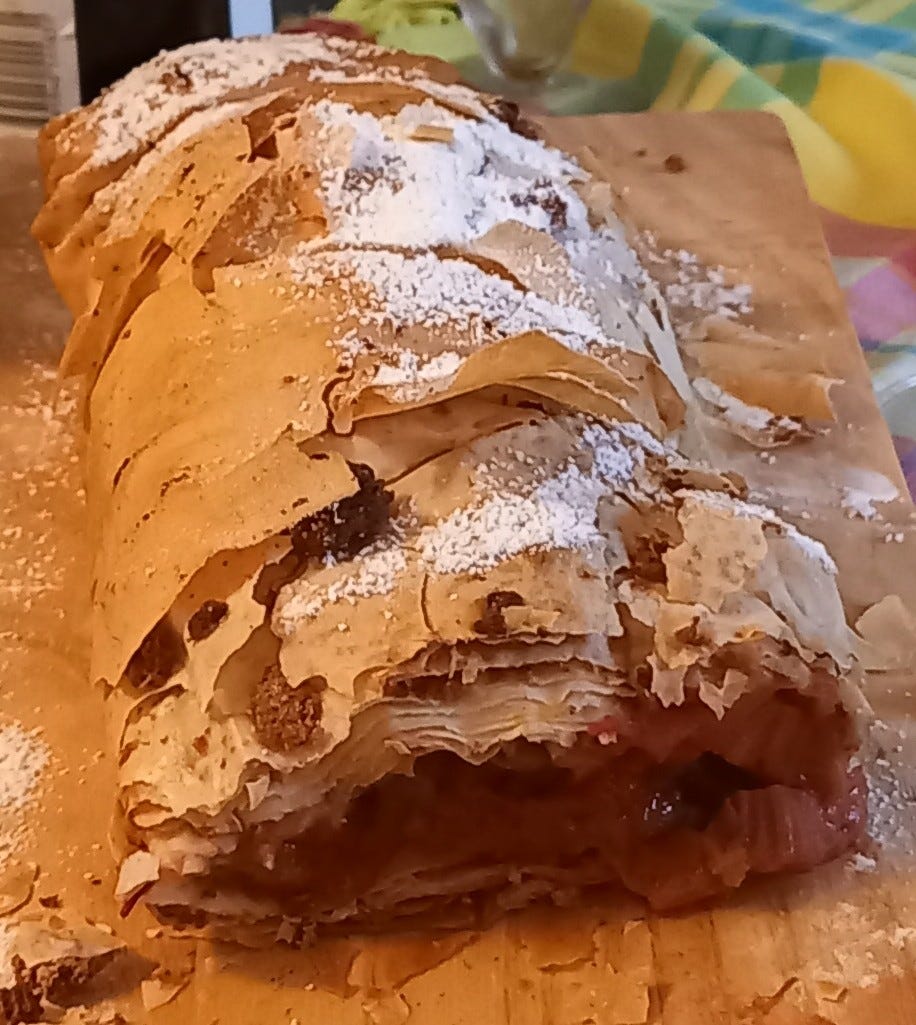
Cocktail shots (a pun) have become as influential on social media as have photos of what foodies are scoffing. Associated with the black-and-white mystique of films starring Humphrey Bogart, Bette Davis, Clark Gable and bare-shouldered women, with bit parts for many equally smouldering cigarettes, there’s glamour and sophistication attached to a cocktail. Bar (another pun?) when it comes to some of their more recent names.
The jiggling up and down of a shaker, its metal casing weeping with cold, makes for the whipping out of phone cameras to record every stage of the cocktail’s creation. You haven’t already forgotten, have you, how stirred (and considerably shaken) we were by the video of Stanley Tucci making a Negroni? It kept us going during Covid.
There is zero foodie equivalent. No star wants to be filmed chewing food or open-mouthed shovelling in a forkful. Cocktails encourage a certain louche demeanour not provoked by a pint of lager or a glass of wine, and never a helping of stew. To the point where at some moment in the week or the month, or, with Dry January, the entire wretched month, a hiatus could be called for.
No-one really knows what the medically-recommended 14 units of alcohol a week amount to, just that they’ve probably not only been reached but overtaken. Then the drinking choice is either nothing at all or water or a soda. In my case, it's sugar-free ginger beer whose sweetness, as it does in all diet sodas, comes from aspartame.
But even that alternative may soon be denied us. Concern has been renewed over aspartame’s safety.
Roughly 200 times sweeter than sugar and, in these sugar-tax, cost-cutting times, up to 80 percent cheaper, aspartame is used in more than 6000 food and drink items running the gamut from Diet Coke to Wrigley’s sugar-free gum, with yogurts and low-calorie weight control foods in between.
The first call for a ban on aspartame came back in the 1970s after research was published by the University of Sussex linking it to lung and liver cancer, an increased risk of brain damage and brain lesions, and neuroendocrine disorders. These interfere with the interaction of the nervous system and the glands that produce the hormones regulating much of the body’s functions.
40 percent of all consumers eat or drink products containing aspartame, according to YouGov research. With concern rising over its potential carcinogenic effects, the World Health Organization’s International Agency for Research on Cancer stepped in once again in 2023 to investigate. It confirmed that July that it had found aspartame might be “possibly carcinogenic”. It recommended that non-sugar sweeteners should not be used as part of weight loss programmes, pointing to evidence that suggested “there may be potential undesirable effects from long-term use of NSS, such as an increased risk of type 2 diabetes, cardiovascular diseases, and mortality in adults.”
With other items on the IARC’s “possibly carcinogenic” list including eating red meat, using mobile phones, aloe vera, diesel, working overnight, and pickled Asian vegetables, the list itself might benefit from further scrutiny. But the IARC made it clear that so long as consumption was kept within a daily intake of 40mg/kg body weight, whatever the dickens that amounts to, it was safe to consume - but that further research was required.
New results have now come in, from Sweden’s Karolinska Institute, which found that aspartame triggers an insulin surge that causes plaque to build up in the arteries, along with inflammation that together could lead to “life-threatening cardiovascular issues.” That would be ‘heart attacks’ to you and me. Data from NIH, the National Institute of Health and Medical Research, claims as little as half a can daily of aspartame-containing soda could increase cancer risks. The average American drinks two cans of diet soda a day.
As is frequent in these investigations, three years prior, Australia’s University of Queensland found conflicting evidence: so long as the quantities of aspartame weren’t so great as to cause an arrhythmic heartbeat, it could improve calcium control and the force of heart contractions. But in 2021, it found that use of non-sugar sweeteners aspartame and other sweeteners can speed up the spread of antibiotic resistance.

No surprise that the International Sweeteners Association, a lobbying group representing among other suppliers PepsiCo, Tate & Lyle, Cargill and Mars Wrigley, argues information used to provoke an aspartame ban is misleading. It cites a statement that food safety authorities “including the Joint Expert Committee on Food Additives of the WHO and EFSA have reviewed aspartame and found that its use is safe.” That WHO and EFSA statement is twelve years old.
There is big money riding on preventing a ban on aspartame. This would be catastrophic for the food and drinks industry. Can you imagine the cost of reformulating those 6000+ products? And how long it would take to come up with an acceptable alternative sweetener? Not months but probably years. They will be scurrying to fund scientific research that gets them off the hook.
This fresh anxiety has been driven by Yuka, a scanning app supposed to help consumers better understand the benefits of the foods they eat. It wants all chemical sweeteners banned. 95 percent of their 45 million users have apparently stopped buying and eating food containing aspartame. Co-founder Julie Chapon says, “The guidelines of safe consumption levels are from the previous European Food Safety Agency assessment in 2013 and within that 10 years there have been more studies linking aspartame to cancer and other diseases.”
Aspartame was discovered by accident, in 1965 by a chemist working for the Skokie, Illinois-based company GD Searle & Co, who, in assessing an anti-ulcer drug he was working on, licked his finger and found it sweet. In 1985, GD Searle was bought by Monsanto, who turned the aspartame side into a separate division, NutraSweet. When Pharmacia & Upjohn merged with Monsanto in 2000, it become the Pharmacia Corporation which was acquired by Pfizer in 2003.
The world’s largest pharmaceutical company with revenues of $58.5 billion, Pfizer shareholders own around 77 percent of the company. It’s a huge amount of money they want to protect. In 2024, Pfizer’s total lobbying expenditure by its 50 lobbyists came to $10,070,000. Of those 50 lobbyists, 43 have previously held government jobs.
Dana Small, a professor of psychiatry at Canada’s McGill University, says of artificial sweeteners, “We know enough to know that we don’t know enough. And so I think that the feelings of safety around artificial sweeteners are not warranted.”
Sucralose (Splenda) is around 600 times sweeter than sugar. Saccharin (Sweet‘N Low among others) is between 200-700 times sweeter than sugar. Acesulfame K is about 200 times sweeter than sugar. Of the natural plant-sourced sweeteners, Stevia is around 350 times sweeter than sugar. Monk fruit extract is the same. Allulose is not as sweet but offers the ‘mouth feel’ of sugar.
Our best health is achieved, if we are fortunate enough to afford it and have the time in our schedules to cook, by eating natural foods. If we need to reduce our sugar intake, that’s something we can work on, tough though it can be. Sugar or honey or natural sweeteners are less detrimental than laboratory contrived replacements.
This strudel is a recipe I confess I gave out in the early days of Tabled when loyal friends were my few readers; but it sees out the rhubarb season that is now winding down and I’ve tweaked it a little. It looks impressive (or it did before I attacked it with a knife, forgetting first to photograph it) yet is extremely easy to put together. While it’s best eaten warm with cream, it can be made ahead, even the day before, as the pastry doesn’t get soggy.
500g/1lb fresh rhubarb
9 sheets phyllo pastry (half a packet)
225g/1 cup butter, melted
225g crushed amaretti (about 8)
90g/½ cup golden caster sugar
1 teaspoon rosewater (optional) or 2 teaspoons ground cinnamon or ground ginger
grated zest of one large orange, preferably Blood Orange, scrubbed
75g/½ cup chopped pistachios or toasted walnuts
Crème fraîche, double cream, crème anglaise or vanilla ice cream to serve
Preheat oven to 180C/375F.
Slice the rhubarb into 2cm/¾in chunks. Blanch them in boiling water 1½ minutes, drain and pat dry.
Lay a sheet of phyllo on a clean counter or large baking sheet. Keep the rest covered with a damp cloth - it dries out really fast! Brush the sheet with melted butter then sprinkle it with 2 or 3 tablespoons of amaretti crumbs. Repeat four more times, using up all the amaretti crumbs up, then add two more buttered sheets without amaretti.
Spoon the rhubarb pieces in a compact line along the longer side of the phyllo, 5cm/2 ins away from its edge. Sprinkle it with the sugar, rosewater or cinnamon or ginger, the orange zest and pistachios or walnuts. Lay over 2 more sheets of phyllo, brushing each of them with butter.
Starting from the rhubarb edge of the phyllo, roll up the sheets tightly like a roulard cake. Set the roll seam side down onto a baking sheet, tucking the ends underneath it, and brush the roll with butter.
Bake 40-50 minutes till golden. Rest it 4-5 minutes before slicing it, most easily with a serrated bread knife. Serve with crème fraîche, double cream, crème anglaise or vanilla ice cream. If you haven’t drunk the juice from the orange, whisking continuously to avoid any curdling, trickle it slowly into the crème fraîche, cream or custard.






Fascinating. Pharmaceutical companies investing in the things that create the problems they have the 'solutions' for. We have seen this before and some names just keep coming up. Dark. Thanks Julia.
Interesting! I find aspartame and saccharin both leave an unpleasant after-taste, so I tend to avoid stuff containing them. Also interesting that your rhubarb season is winding down - my rhubarb is currently 4" tall!